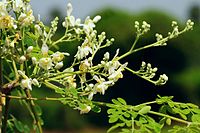
Photo from wikipedia
In this study, Moringa oleifera seed protein-montmorillonite (MOSP-MMT) composite was synthetized using the impregnation method. The MOSP-MMT adsorbent was characterized using scanning electron microscope, X-ray diffraction, infrared spectroscopy, surface area… Click to show full abstract
In this study, Moringa oleifera seed protein-montmorillonite (MOSP-MMT) composite was synthetized using the impregnation method. The MOSP-MMT adsorbent was characterized using scanning electron microscope, X-ray diffraction, infrared spectroscopy, surface area analysis, and thermogravimetric analysis. The removal of water-soluble reactive red 2 (RR-2) from artificial wastewater by the MOSP-MMT composite was carried out in a batch system. The results indicated that RR-2 adsorption increased with contact time, and the pseudo-second-order equation was best to describe the adoption process among the three models. The RR-2 adsorption decreased from 7.60 to 5.92 mg/g as pH increased from 3.2 to 9.1 and increased from 15.2 to 17.1 mg/g as NaCl concentration increased from 0 to 30 g/L. The Freundlich isotherm model provided the better fit of the experimental data than the Langmuir model. The result showed that the MOSP-MMT composite could be a potential adsorbent for the treatment of wastewater containing RR-2.
Journal Title: Journal of Chemistry
Year Published: 2019
Link to full text (if available)
Share on Social Media: Sign Up to like & get
recommendations!